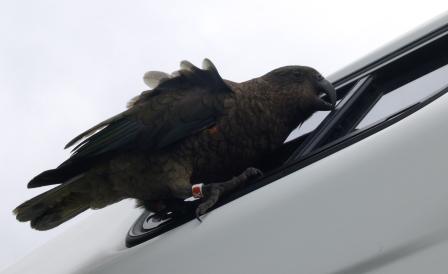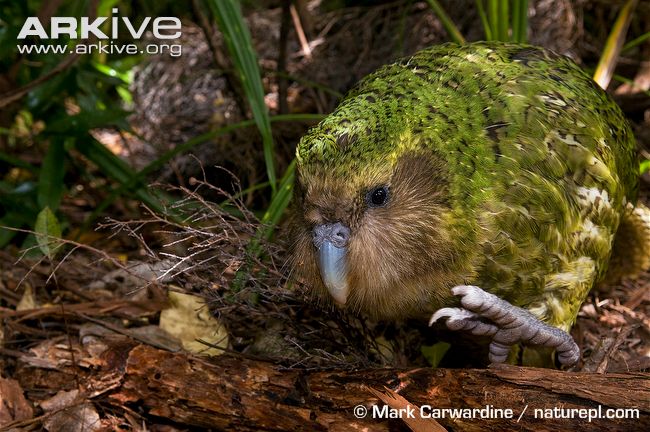Pretty Pollys

VulcanSpirit
Richard & Alison Brunstrom
Fri 3 May 2013 11:30
|
NZ has three species of parrot, and being NZ they
just have to have "the world's only ...."; in this case 'the world's only
mountain parrot' and 'the world's only flightless parrot' which is also 'the
world's heaviest parrot'. Not bad for a small island. We got to see two out of
three, the kea and the kaka.
This is a kaka, the Brown or Bush Parrot Nestor
meridionalis :
 These are big birds living on fruit in native
forest. This is a young bird, part of a successful reintroduction in the
Wellington area to the wonderful Zealandia wildlife refuge. They are breeding
well right in the centre of the capital city and expanding rapidly out into the
surrounding suburbs; kaka are flying in the skies above Wellington for the first
time in perhaps 100 years.
This guy is a kea or Mountain Parrot Nestor
notabilis:
 A much greener bird with a very strongly hooked
beak, obviously closely related to the kaka. These really are the world's only
montane parrots, found only in the South Island's high altitude forests up to
2100m. they're not all green though; in flight they have red and yellow on
the wings which you can see here during preening:
 Kea were persecuted for a very long time by sheep
farmers - indeed there was a bounty on them until fairly recently. They are
omnivores and will feed on carrion - but just as in the UK this leads farmers to
claim that they kill lambs not merely eat dead ones. There is not and never was
a shred of evidence to support this contention, but that didn't stop the
slaughter. Kea were very lucky to survive and are still endangered but seem to
be growing in numbers now (accurate population counts are almost impossible in
their home terrain). But they have become tame to the point of being a nuisance
in one or two of the alpine passes - stealing food like seagulls in the UK and
for some reason ripping the trim off vehicles, for which they seem to have a
real passion. Here is one trying to destroy a window seal on our
campervan:
 Since he was on the roof out of reach he had to be
dissuaded with gravel. I think he would have got the window out if we'd left the
van unattended.
Kea and kaka are obviously very closely related -
in fact kea probably diverged from kaka quite recently as they adapted to life
in the 'new' Southern Alps - mountains which started forming a mere 5 million
years ago. But as a group these big parrots have been isolated in NZ
for a very long time, possibly since NZ left Australia 80m years ago, and
the third member of the tribe is very special.
The kakapo or Ground Parrot Strigops
habroptlius is a very unusual bird indeed. We didn't see one (only
about 120 survive and access to their reserves is rightly entirely prohibited).
The kakapo is flightless, nocturnal and very large. It lives on the forest floor
and was until the arrival of Europeans very common all over NZ. And just to
rub in its uniqueness, uniquely for a parrot it uses a lekking system for
breeding, like grouse in Europe. The males make a dish-shaped 'booming
bowl' in the forest litter from which they call to attract females. They
are opportunistic breeders, eggs being produced only every 3-5 years when their
main food supply, the rimu tree, has a good season. What did for them was the
brilliant wheeze of introducing European stoats to control the European rabbits.
Stoats much prefer to eat the eggs and chicks of flightless ground nesting birds
and have completely exterminated the kakapo from almost the whole of NZ. Happily
just a few were rescued and transplanted to two offshore stoat & rat free
islands (they need to be a way offshore because both stoats and rats will swim
in the sea). These birds very very nearly went extinct, but a recovery programme
is underway and making slow progress. The future of this extraordinary
bird is not yet secure, but it looks a lot rosier than it did a few years
ago. Here is a plucky survivor marching through the forest on Codfish
Island:
 |